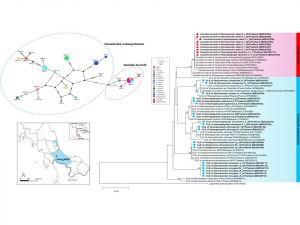Highlight Activities 2025: Molecular prevalence of Coxiella like endosymbionts and the first record of Coxiella burnetii in hard ticks from Southern Thailand
การตรวจแบคทีเรีย Coxiella like endosymbionts ในระดับชีวโมเลกุล และการค้นพบ Coxiella burnetii เป็นครั้งแรกในเห็บแข็งจากภาคใต้ของประเทศไทย
Ticks act as vectors for a variety of pathogens, resulting in tick-borne diseases that impact both animals and humans. A total of 466 ticks collected from vegetation in Songkhla Province, Southern Thailand, were identified as 8 hard tick species: Dermacentor compactus (n=150), D. steini (n=100), D. auratus (n=85), D. tricuspis (n=41), Haemaphysalis hystricis (n=69), H. semermis (n=3), H. shimoga (n=2), and Amblyomma testudinarium (n=16). In 93 ticks from these eight species, Coxiella bacteria were detected, including two distinct groups: Coxiella burnetii and Coxiella-like endosymbionts (CLEs). Coxiella burnetii is reported for the first time in H. hystricis and D. steini in the country while CLEs are detected in seven tick species, including D. compactus, D. auratus, D. tricuspis, H. hystricis, H. semermis, H. shimoga and A. testudinarium. Among these, CLEs associated with D. compactus, H. hystricis and H. semermis are new records in Thailand. DNA sequencing, phylogenetic analysis and generation of a haplotype network clearly revealed two distinct groups of Coxiella bacteria: C. burnetii and CLEs. Additionally, the nucleotide alignment of Coxiella 16S rRNA revealed differences in bases at 3 positions between C. burnetii and CLEs. This study also highlights the high diverse species of tick observed in southern Thailand.
เห็บเป็นพาหะนำโรคหลายชนิด ซึ่งก่อให้เกิดโรคที่ส่งผลกระทบทั้งในคนและสัตว์ งานวิจัยนี้เก็บรวบรวมตัวอย่างเห็บจำนวน 466 ตัว จากพืชในจังหวัดสงขลาภาคใต้ของประเทศไทย ซึ่งพบเห็บแข็ง 8 ชนิด ได้แก่ Dermacentor compactus จำนวน 150 ตัว D. steini จำนวน 100 ตัว D. auratus จำนวน 85 ตัว D. tricuspis จำนวน 41 ตัว Haemaphysalis hystricis จำนวน 69 ตัว H. semermis จำนวน 3 ตัว H. shimoga จำนวน 2 ตัว และ Amblyomma testudinarium จำนวน 16 ตัว โดยตรวจพบแบคทีเรีย Coxiella ในเห็บ 93 ตัวจากเห็บทั้งหมด 8 ชนิด โดยพบเชื้อ Coxiella แบ่งออกเป็นสองกลุ่ม ได้แก่ Coxiella burnetii และ Coxiella-like endosymbionts (CLEs) งานวิจัยครั้งนี้เป็นรายงานการพบเชื้อ Coxiella burnetii ในเห็บ H. hystricis และ D. steini เป็นครั้งแรกในประเทศไทย ในขณะที่กลุ่ม CLEs ตรวจพบในเห็บ 7 ชนิด ได้แก่ D. compactus D. auratus D. tricuspis H. hystricis H. semermis H. shimoga และ A. testudinarium โดยพบว่า CLEs ที่พบใน D. compactus H. hystricis และ H. semermis เป็นรายงานใหม่ในประเทศไทย ผลจากการศึกษาด้วยการวิเคราะห์ลำดับดีเอ็นเอ การวิเคราะห์ทางวิวัฒนาการและการสร้างความสัมพันธ์ของแฮไพลไทป์แสดงให้เห็นกลุ่มแบคทีเรีย Coxiella แบ่งออกเป็น 2 กลุ่มอย่างชัดเจน ได้แก่ C. burnetii และ CLEs นอกจากนี้การวิเคราะห์ลำดับนิวคลีโอไทด์ของยีน 16S rRNA พบความแตกต่างของเบสจำนวน 3 ตำแหน่งระหว่างกลุ่ม C. burnetii และ CLEs ซึ่งข้อมูลที่ได้จากการศึกษาครั้งนี้ยังแสดงให้เห็นถึงความหลากหลายของชนิดเห็บที่พบในภาคใต้ของประเทศไทยอีกด้วย
งานวิจัยครั้งนี้สอดคล้องกับเป้าหมายที่ 3 ของแผนการพัฒนาที่ยั่งยืน (SDGs) สร้างหลักประกันการมีสุขภาวะที่ดี และส่งเสริมความเป็นอยู่ที่ดีสำหรับทุกคนในทุกช่วงวัย และมุ่งในประเด็นเป้าหมายย่อย 3.3 ยุติการแพร่กระจายของเอดส์ วัณโรค มาลาเรีย และโรคเขตร้อนที่ถูกละเลย และต่อสู้กับโรคตับอักเสบ โรคติดต่อทางน้ำและโรคติดต่ออื่นๆ ภายในปี พ.ศ. 2573
Nooma W, Kaenkan W, Trinachartvanit W, Baimai V, Ahantarig A. Molecular prevalence of Coxiella like endosymbionts and the first record of Coxiella burnetii in hard ticks from Southern Thailand. Sci Rep. 2025;15(1):10129. https://doi.org/10.1038/s41598-025-94605-x


